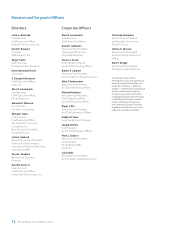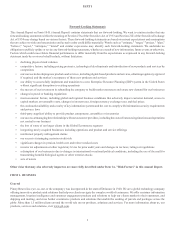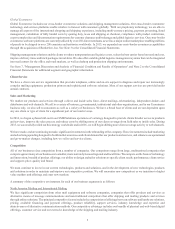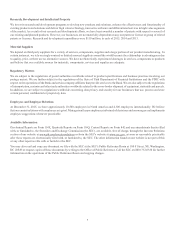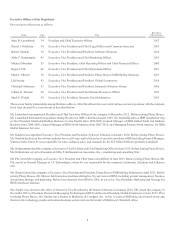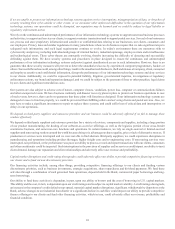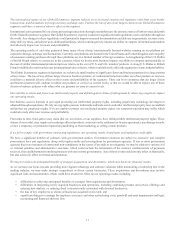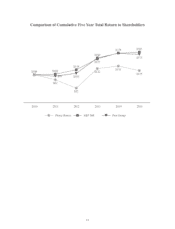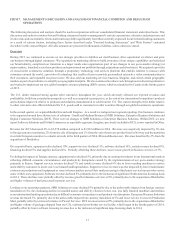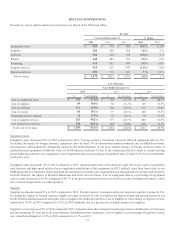Pitney Bowes 2015 Annual Report Download - page 26
Download and view the complete annual report
Please find page 26 of the 2015 Pitney Bowes annual report below. You can navigate through the pages in the report by either clicking on the pages listed below, or by using the keyword search tool below to find specific information within the annual report.10
If we are unable to protect our information technology systems against service interruptions, misappropriation of data, or breaches of
security resulting from cyber-attacks or other events, or we encounter other unforeseen difficulties in the operation of our information
technology systems, our operations could be disrupted, our reputation may be harmed and we could be subject to legal liability or
regulatory enforcement action.
We rely on the continuous and uninterrupted performance of our information technology systems to support numerous business processes
and activities, to support and service our clients, to support consumer transactions and to support postal services. Several of our businesses
use, process and store proprietary information and sensitive or confidential data relating to our businesses, our clients, consumers and
our employees. Privacy laws and similar regulations in many jurisdictions where we do business require that we take significant steps to
safeguard such information, and such legal requirements continue to evolve. In today's environment there are numerous risks to
cybersecurity and privacy, including individual and groups of criminal hackers, industrial espionage, employee errors and/or malfeasance
and technological errors. These cyber threats are constantly evolving, thereby increasing the difficulty of detecting and successfully
defending against them. We have security systems and procedures in place designed to ensure the continuous and uninterrupted
performance of our information technology systems and protect against unauthorized access to such information. However, there is no
guarantee that these security measures will prevent or detect the unauthorized access by experienced computer programmers, hackers or
others. Successful breaches could, among other things, result in the unauthorized disclosure, theft and misuse of company, client, consumer
and employee sensitive and confidential information, disrupt the performance of our information technology systems and deny services
to our clients. Additionally, we could be exposed to potential liability, litigation, governmental inquiries, investigations or regulatory
enforcement actions, our brand and reputation damaged, and we could be subject to the payment of fines or other penalties, legal claims
by our clients and significant remediation costs.
Our systems are also subject to adverse acts of nature, computer viruses, vandalism, power loss, computer or communications failures
and other unexpected events. We have business continuity and disaster recovery plans in place to protect our business operations in case
of such events; however, there can be no guarantee that these plans will function as designed. If our information technology systems are
damaged or cease to function properly, we could be prevented from fulfilling orders and servicing clients and postal services. Also, we
may have to make a significant investment to repair or replace these systems, and could suffer loss of critical data and interruptions or
delays in our operations.
We depend on third-party suppliers and outsource providers and our business could be adversely affected if we fail to manage these
vendors effectively.
We depend on third-party suppliers and outsource providers for a variety of services, components and supplies, including a large portion
of our product manufacturing, the hosting of our software-as-a-service offerings, as well as the logistics portion of our cross-border
ecommerce business, and some non-core functions and operations. In certain instances, we rely on single-sourced or limited-sourced
suppliers and outsourcing vendors around the world because doing so is advantageous due to quality, price or lack of alternative sources. If
production or services were interrupted and we were not able to find alternate third-party suppliers, we could experience disruptions in
manufacturing and operations including product shortages, higher freight costs and re-engineering costs. If outsourcing services were
interrupted, not performed, or the performance was poor, our ability to process, record and report transactions with our clients, consumers
and other constituents could be impacted. Such interruptions in the provision of supplies and/or services could impact our ability to meet
client demand, damage our reputation and client relationships and adversely affect our revenue and profitability.
Capital market disruptions and credit rating downgrades could adversely affect our ability to provide competitive financing services to
our clients and to fund various discretionary priorities.
Our financing activities include, among other things, providing competitive financing offerings to our clients and funding various
discretionary priorities, such as business investments, strategic acquisitions, share repurchases and dividend payments. We fund these
activities through a combination of cash generated from operations, deposits held in the Bank, commercial paper borrowings and long-
term borrowings.
Our ability to fund these activities is dependent, in part, upon our ability to borrow and the cost of borrowing in U.S. capital markets.
This ability and the cost, in turn, is dependent upon our credit ratings and is subject to capital market volatility. A credit ratings downgrade,
an increase in the company's credit default swap spread, material capital market disruptions, significant withdrawals by depositors at the
Bank, adverse changes to our industrial loan charter or a significant decline in cash flow could impact our ability to provide competitive
finance offerings to our clients and fund other financing activities, which in turn, could adversely affect our revenue, profitability and
financial condition.


